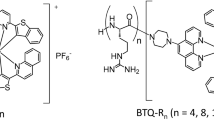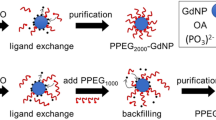Abstract
Viral nanoparticles are a novel class of biomolecular agents that take advantage of the natural circulatory and targeting properties of viruses to allow the development of therapeutics, vaccines and imaging tools. We have developed a multivalent nanoparticle platform based on the cowpea mosaic virus (CPMV) that facilitates particle labeling at high density with fluorescent dyes and other functional groups. Compared with other technologies, CPMV-based viral nanoparticles are particularly suited for long-term intravital vascular imaging because of their biocompatibility and retention in the endothelium with minimal side effects. The stable, long-term labeling of the endothelium allows the identification of vasculature undergoing active remodeling in real time. In this study, we describe the synthesis, purification and fluorescent labeling of CPMV nanoparticles, along with their use for imaging of vascular structure and for intravital vascular mapping in developmental and tumor angiogenesis models. Dye-labeled viral nanoparticles can be synthesized and purified in a single day, and imaging studies can be conducted over hours, days or weeks, depending on the application.
This is a preview of subscription content, access via your institution
Access options
Subscribe to this journal
Receive 12 print issues and online access
$259.00 per year
only $21.58 per issue
Buy this article
- Purchase on Springer Link
- Instant access to full article PDF
Prices may be subject to local taxes which are calculated during checkout






Similar content being viewed by others
References
Carmeliet, P. Angiogenesis in life, disease and medicine. Nature 438, 932–936 (2005).
Destito, G., Schneemann, A. & Manchester, M. Biomedical nanotechnology using virus-based nanoparticles. Curr. Top Microbiol. Immunol. 327, 95–122 (2009).
Manchester, M. & Singh, P. Virus-based nanoparticles (VNPs): platform technologies for diagnostic imaging. Adv. Drug Deliv. Rev. 58, 1505–1522 (2006).
Young, M., Willits, D., Uchida, M. & Douglas, T. Plant viruses as biotemplates for materials and their use in nanotechnology. Annu. Rev. Phytopathol. 46, 361–384 (2008).
Lewis, J.D. et al. Viral nanoparticles as tools for intravital vascular imaging. Nat. Med. 12, 354–360 (2006).
Lin, T. et al. The refined crystal structure of cowpea mosaic virus at 2.8 A resolution. Virology 265, 20–34 (1999).
Chatterji, A. et al. New addresses on an addressable virus nanoblock; uniquely reactive Lys residues on cowpea mosaic virus. Chem. Biol. 11, 855–863 (2004).
Wang, Q., Kaltgrad, E., Lin, T., Johnson, J.E. & Finn, M.G. Natural supramolecular building blocks. Wild-type cowpea mosaic virus. Chem. Biol. 9, 805–811 (2002).
Medintz, I.L. et al. Decoration of discretely immobilized cowpea mosaic virus with luminescent quantum dots. Langmuir 21, 5501–5510 (2005).
Singh, P. et al. Bio-distribution, toxicity and pathology of cowpea mosaic virus nanoparticles in vivo . J. Control Release. 120, 41–50 (2007).
Sapsford, K.E. et al. A cowpea mosaic virus nanoscaffold for multiplexed antibody conjugation: application as an immunoassay tracer. Biosens. Bioelectron. 21, 1668–1673 (2006).
Chatterji, A. et al. Chemical conjugation of heterologous proteins on the surface of Cowpea mosaic virus. Bioconjug. Chem. 15, 807–813 (2004).
Sen Gupta, S. et al. Accelerated bioorthogonal conjugation: a practical method for the ligation of diverse functional molecules to a polyvalent virus scaffold. Bioconjug. Chem. 16, 1572–1579 (2005).
Martin, B.D. et al. An engineered virus as a bright fluorescent tag and scaffold for cargo proteins—capture and transport by gliding microtubules. J. Nanosci. Nanotechnol. 6, 2451–2460 (2006).
Brunel, F.M. et al. Hydrazone ligation strategy to assemble multifunctional viral nanoparticles for cell imaging and tumor targeting. Nano. Lett. 10, 1093–1097 (2010).
Destito, G., Yeh, R., Rae, C.S., Finn, M.G. & Manchester, M. Folic acid-mediated targeting of cowpea mosaic virus particles to tumor cells. Chem. Biol. 14, 1152–1162 (2007).
Raja, K.S. et al. Hybrid virus-polymer materials. 1. Synthesis and properties of PEG-decorated cowpea mosaic virus. Biomacromolecules 4, 472–476 (2003).
Steinmetz, N.F. & Manchester, M. PEGylated viral nanoparticles for biomedicine: the impact of PEG chain length on VNP cell interactions in vitro and ex vivo . Biomacromolecules 10, 784–792 (2009).
Gonzalez, M.J., Plummer, E.M., Rae, C.S. & Manchester, M. Interaction of Cowpea mosaic virus (CPMV) nanoparticles with antigen presenting cells in vitro and in vivo . PLoS One 4, e7981 (2009).
Shriver, L.P., Koudelka, K.J. & Manchester, M. Viral nanoparticles associate with regions of inflammation and blood brain barrier disruption during CNS infection. J. Neuroimmunol. 211, 66–72 (2009).
Brennan, F.R., Jones, T.D. & Hamilton, W.D. Cowpea mosaic virus as a vaccine carrier of heterologous antigens. Mol. Biotechnol. 17, 15–26 (2001).
Lomonossoff, G.P. & Shanks, M. The nucleotide sequence of cowpea mosaic virus B RNA. EMBO J. 2, 2253–2258 (1983).
Nicholas, B.L. et al. Characterization of the immune response to canine parvovirus induced by vaccination with chimaeric plant viruses. Vaccine 20, 2727–2734 (2002).
Yang, C.S. et al. Nanoparticle-based in vivo investigation on blood-brain barrier permeability following ischemia and reperfusion. Anal. Chem. 76, 4465–4471 (2004).
Hainfeld, J.F., Slatkin, D.N., Focella, T.M. & Smilowitz, H.M. Gold nanoparticles: a new X-ray contrast agent. Br. J. Radiol. 79, 248–253 (2006).
Josephson, L., Kircher, M.F., Mahmood, U., Tang, Y. & Weissleder, R. Near-infrared fluorescent nanoparticles as combined MR/optical imaging probes. Bioconjug. Chem. 13, 554–560 (2002).
Kim, D., Park, S., Lee, J.H., Jeong, Y.Y. & Jon, S. Antibiofouling polymer-coated gold nanoparticles as a contrast agent for in vivo X-ray computed tomography imaging. J. Am. Chem. Soc. 129, 7661–7665 (2007).
Lee, P.J. & Peyman, G.A. Visualization of the retinal and choroidal microvasculature by fluorescent liposomes. Methods Enzymol. 373, 214–233 (2003).
Zheng, J., Liu, J., Dunne, M., Jaffray, D.A. & Allen, C. In vivo performance of a liposomal vascular contrast agent for CT and MR-based image guidance applications. Pharm. Res. 24, 1193–1201 (2007).
Rizzo, V., Steinfeld, R., Kyriakides, C. & DeFouw, D.O. The microvascular unit of the 6-day chick chorioallantoic membrane: a fluorescent confocal microscopic and ultrastructural morphometric analysis of endothelial permselectivity. Microvasc. Res. 46, 320–332 (1993).
Jilani, S.M. et al. Selective binding of lectins to embryonic chicken vasculature. J. Histochem. Cytochem. 51, 597–604 (2003).
Pardanaud, L., Altmann, C., Kitos, P., Dieterlen-Lievre, F. & Buck, C.A. Vasculogenesis in the early quail blastodisc as studied with a monoclonal antibody recognizing endothelial cells. Development 100, 339–349 (1987).
Jayagopal, A., Russ, P.K. & Haselton, F.R. Surface engineering of quantum dots for in vivo vascular imaging. Bioconjug. Chem. 18, 1424–1433 (2007).
Larson, D.R. et al. Water-soluble quantum dots for multiphoton fluorescence imaging in vivo . Science 300, 1434–1436 (2003).
Khurana, M., Moriyama, E.H., Mariampillai, A. & Wilson, B.C. Intravital high-resolution optical imaging of individual vessel response to photodynamic treatment. J. Biomed. Opt. 13, 040502 (2008).
Mitra, S. & Foster, T.H. In vivo confocal fluorescence imaging of the intratumor distribution of the photosensitizer mono-L-aspartylchlorin-e6. Neoplasia 10, 429–438 (2008).
Bogen, S., Pak, J., Garifallou, M., Deng, X. & Muller, W.A. Monoclonal antibody to murine PECAM-1 (CD31) blocks acute inflammation in vivo . J. Exp. Med. 179, 1059–1064 (1994).
Chan, W.H., Shiao, N.H. & Lu, P.Z. CdSe quantum dots induce apoptosis in human neuroblastoma cells via mitochondrial-dependent pathways and inhibition of survival signals. Toxicol. Lett. 167, 191–200 (2006).
Cho, S.J. et al. Long-term exposure to CdTe quantum dots causes functional impairments in live cells. Langmuir 23, 1974–1980 (2007).
Hardman, R. A toxicologic review of quantum dots: toxicity depends on physicochemical and environmental factors. Environ. Health Perspect. 114, 165–172 (2006).
Prato, M., Kostarelos, K. & Bianco, A. Functionalized carbon nanotubes in drug design and discovery. Acc. Chem. Res. 41, 60–68 (2008).
Takagi, A. et al. Induction of mesothelioma in p53+/− mouse by intraperitoneal application of multi-wall carbon nanotube. J. Toxicol. Sci. 33, 105–116 (2008).
Lasagna-Reeves, C. et al. Bioaccumulation and toxicity of gold nanoparticles after repeated administration in mice. Biochem. Biophys. Res. Commun. 393, 649–655.
Ochoa, W.F., Chatterji, A., Lin, T. & Johnson, J.E. Generation and structural analysis of reactive empty particles derived from an icosahedral virus. Chem. Biol. 13, 771–778 (2006).
Rae, C. et al. Chemical addressability of ultraviolet-inactivated viral nanoparticles (VNPs). PLoS One 3, e3315 (2008).
Saunders, K., Sainsbury, F. & Lomonossoff, G.P. Efficient generation of cowpea mosaic virus empty virus-like particles by the proteolytic processing of precursors in insect cells and plants. Virology 393, 329–337 (2009).
Liebermann, H. & Mentel, R. Quantification of adenovirus particles. J. Virol. Methods. 50, 281–291 (1994).
Wang, F. In Vitro Cellular & Developmental Biology—Animal (Springer Berlin, Heidelberg, Germany, 2003).
Zijlstra, A., Lewis, J., Degryse, B., Stuhlmann, H. & Quigley, J.P. The inhibition of tumor cell intravasation and subsequent metastasis via regulation of in vivo tumor cell motility by the tetraspanin CD151. Cancer Cell 13, 221–234 (2008).
Carrillo-Tripp, M. et al. VIPERdb2: an enhanced and web API enabled relational database for structural virology. Nucleic Acids Res. 37, D436–D442 (2009).
Acknowledgements
This study was supported by an American Heart Association Postdoctoral Fellowship (N.F.S.) as well as by the following grants: Canadian Institutes for Health Research grant MOP-84535 (J.D.L.), and US National Institutes of Health grants R01 CA112075 (M.M.), R01 HL 068648 (H.S.) and K99 EB009105 (N.F.S.).
Author information
Authors and Affiliations
Contributions
H.S.L., A.A., J.D.L., A.Z. and H.S. developed the animal models and conducted intravital imaging experiments. N.F.S., G.D. and M.M. prepared and characterized the viral nanoparticles; H.S.L., N.F.S., A.A., H.S., M.M., A.Z. and J.D.L. wrote the paper.
Corresponding author
Ethics declarations
Competing interests
The authors declare no competing financial interests.
Supplementary information
Supplementary Movie 1: Real time imaging of murine embryo yolk sac vasculature.
CPMV-A555 was injected intravenously and widefield fluorescence images acquired every 300 msecs. Images shown reveal capillaries feeding into larger veins. (AVI 4300 kb)
Supplementary Movie 2: Real time imaging of murine embryo vasculature.
CPMV-A555 was injected intravenously and widefield fluorescence images acquired every 300 msecs. The top vessel represents an artery and the bottom vessel is a vein. (AVI 1601 kb)
Supplementary Movie 3: Real time imaging of blood cell transit within the avian embryo chorioallantoic membrane (CAM).
CPMV-A555 was injected intravenously and widefield fluorescence images acquired every 100 msecs. To the left is a vein and individual immune cells that have endocytosed labeled viral nanoparticles can be seen traversing across the CAM plexus (right of vein). (AVI 6257 kb)
Supplementary Movie 4: Real time imaging of pre-angiogenic tumor vasculature.
CPMV-A555 was injected intravenously and widefield fluorescence images acquired every 300 msecs. CPMV-A555 reveals the pre-angiogenic vascular network surrounding the primary tumor. Blood cell transit can be visualized within each vessel. (AVI 3822 kb)
Supplementary Movie 5: Real time imaging of tumor vasculature.
CPMV-A555 was injected intravenously and widefield fluorescence images acquired every 300 msecs. CPMV-A555 reveals a tortuous vascular network supporting the primary tumor (bottom middle). (AVI 4044 kb)
Rights and permissions
About this article
Cite this article
Leong, H., Steinmetz, N., Ablack, A. et al. Intravital imaging of embryonic and tumor neovasculature using viral nanoparticles. Nat Protoc 5, 1406–1417 (2010). https://doi.org/10.1038/nprot.2010.103
Published:
Issue Date:
DOI: https://doi.org/10.1038/nprot.2010.103
This article is cited by
-
Longitudinal bioluminescence imaging to monitor breast tumor growth and treatment response using the chick chorioallantoic membrane model
Scientific Reports (2022)
-
On the issue of transparency and reproducibility in nanomedicine
Nature Nanotechnology (2019)
-
Display of single-chain variable fragments on bacteriophage MS2 virus-like particles
Journal of Nanobiotechnology (2017)
-
Hypoxia-induced mobilization of NHE6 to the plasma membrane triggers endosome hyperacidification and chemoresistance
Nature Communications (2017)
-
Quantification of cancer cell extravasation in vivo
Nature Protocols (2016)
Comments
By submitting a comment you agree to abide by our Terms and Community Guidelines. If you find something abusive or that does not comply with our terms or guidelines please flag it as inappropriate.



